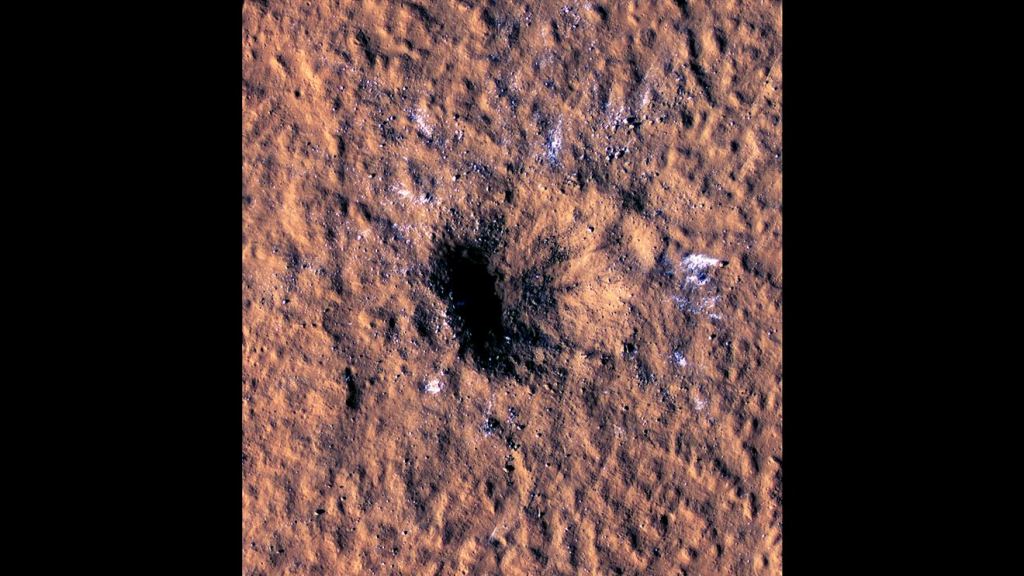The Mars InSight lander might be nearing the end of its life on the Red Planet, but its scientific data are still shaking up the planetary science community. That’s because it detected another Marsquake on December 24, 2021. It was a major shaker and generated surface waves that rippled across the crust of the planet.
The data from that quake allowed science team members to get a better idea of the Martian crust’s structure. Now, this wasn’t just any old magnitude-4 Marsquake. It was evidence of a major meteoroid impact on the planet.
So, scientists began looking for a crater. Before-and-after images from NASA’s Mars Reconnaissance Orbiter (MRO, which reached orbit in 2006) revealed a new one in Amazonis Planitia. That’s a region that lies between the Tharsis and Elysium regions on the planet.
With images and seismic data that pinpoint the crater’s location, scientists think it’s of the largest craters ever witnessed forming any place in the solar system. Of course, many larger ones exist on Mars, but they’re older than any of the missions sent to the Red Planet. Luckily, InSight was there to measure the seismic aftermath of the event.
Scientists used some of its data to create a sound “recording” of the impact. “It’s unprecedented to find a fresh impact of this size,” said Ingrid Daubar of Brown University, who leads InSight’s Impact Science Working Group. “It’s an exciting moment in geologic history, and we got to witness it.
” This video includes a seismogram and sonification of signals received by NASA’s InSight Lander as it detected a meteoroid impact on Mars. Courtesy NASA/JPL-Caltech/Imperial College London. Meet the Meteorite Impactor The crater is about 150 meters across and 21 meters deep.
When the meteoroid hit, it blasted material out from the crust and sent it as far away as 37 kilometers. So, what was this impactor? Based on the available data, the meteoroid was somewhere around 5 to 12 meters in size. On Earth, an object that size would never have reached the surface.
Instead, it would have broken up and vaporized in our atmosphere. But, on Mars, where the atmosphere is quite thin, it just blasted right through to the surface. The crater was first spotted on Feb.
11, 2022, by scientists working at Malin Space Science Systems (MSSS), which built and operates two cameras aboard MRO. The blast zone was visible in data from the MRO. The spacecraft team then correlated with the InSight data taken at the time of the impact.
That allowed them to figure out the epicenter of the impact and start the search for the crash site. “The image of the impact was unlike any I had seen before, with the massive crater, the exposed ice, and the dramatic blast zone preserved in the Martian dust,” said Liliya Posiolova, who leads the Orbital Science and Operations Group at MSSS. “I couldn’t help but imagine what it must have been like to witness the impact, the atmospheric blast, and debris ejected miles downrange.
” Why Bother With Crater-causing Events? Cratering is one of several processes that change the surfaces of worlds in the solar system. Planetary scientists can use the number of craters on a surface to determine how old it is. On Mars, for example, it’s important to know how often craters get dug out of the surface.
That knowledge helps determine the planet’s geologic timeline. The older a region on Mars is, the more craters it has. Aside from aging, craters also provide an important look inside the crust of the planet.
Every time an object gouges out a crater, it reveals materials beneath the surface. On Mars, that turns out to be ice, and the December 24 impactor dug out huge blocks of ice. Mars has a lot of permafrost beneath the surface, so in a sense, the impactor acted as a geological “pick”.
The region where this meteoroid created the crater is fairly close to the Martian equator, so finding ice there is important. Future Mars explorers may be able to use that ice to melt for water, propellants, and other needs. Here’s a simulated flyover of the crater site created by the December 24, 2021 impact event.
Courtesy NASA/JPL-Caltech/University of Arizona. InSight’s Role The December 24, 2021 event wasn’t InSight’s first rodeo with impact-related events. Since landing in November 2018, the spacecraft has detected 1,318 marsquakes, including several caused by smaller meteoroid impacts.
The mission was sent to study the planet’s crust, mantle, and core using seismic waves created by impacts and other events. It has performed well but is starting to lose the power to perform science-gathering tasks. The power drain is largely due to dust on the solar panels, which the teams have tried to shoo off using sand and wind to dislodge the dust grains.
As the power wanes, scientists continue to squeeze every bit of observational time they can out of the mission. The spacecraft now is expected to shut down within the next six weeks, bringing the mission’s science to an end. For More Information NASA’s InSight Lander Detects Stunning Meteoroid Impact on MarsLargest Recent Impact Craters on Mars; Orbital Imaging and Surface Seismic Co-investigation The post InSight Felt the Ground Shake From a Meteorite Impact on Mars appeared first on Universe Today.
.
From: universetoday
URL: https://www.universetoday.com/158390/insight-felt-the-ground-shake-from-a-meteorite-impact-on-mars/



